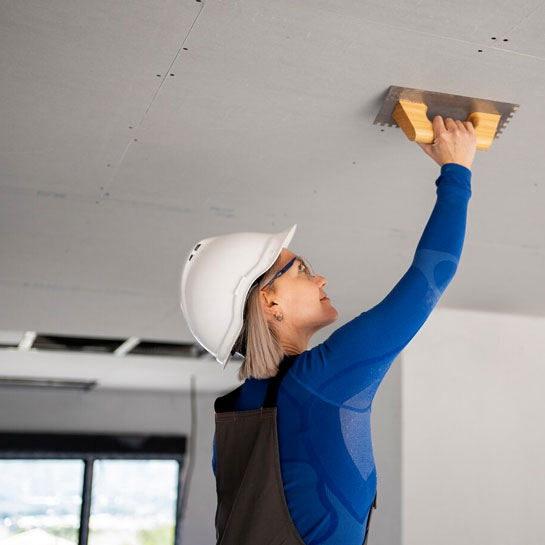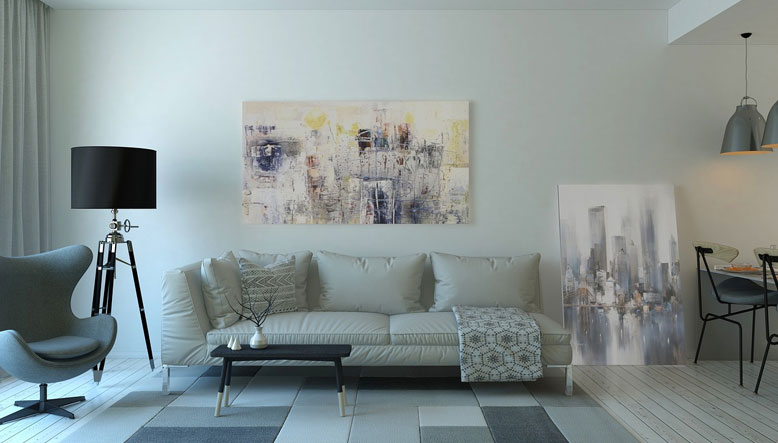Are you thinking about soundproofing the ceiling of any room in your house? This process may seem a bit complicated, but knowing the steps to follow and the types of materials you can choose will make it much easier. In this article, we are going to explain how to do it and give you some tips that will come in handy.
How to soundproof a ceiling?
Noises in a room can become a serious problem that affects your daily life. Footsteps, falling objects…, how can you get rid of this nuisance? The first thing is to take into account these fundamental aspects:
- Identify the noises: A sound caused by impact is not the same as one that travels through the air. The first thing you should be clear about is what type you are going to soundproof, so you can choose the right material.
- Analyze the problem: Is the noise coming from upstairs, or could it be from the street or from the sides? You need to make sure it is coming from the top of your home, otherwise you may be more interested in soundproofing the walls.
Having clarified these concepts, here are the steps you should follow to achieve a soundproof ceiling:
- The first thing is to uncover the ceiling, you should see the wooden guides.
- Next, you have to apply the foam in all the gaps that you can glimpse between the struts. Undoubtedly, this is one of the most important steps and one in which you should put more care.
- Now it is time to place the foam panels or plates.
- Then putty again to seal any cracks that may remain between the plates.
- Finally, install the acoustical panels of your chosen material. Make sure that the clips are securely closed and that there is no gap between them.
Tips you should know before getting to work
If you have never done such a task before, these tips will help you:
- Have comfortable clothes that can be stained to do all the soundproofing.
- It is best not to do this process alone, the panels can be quite heavy and you may need help to lift them.
- Don’t be in a hurry to finish quickly, every step must be done carefully so that it is perfect. Keep in mind that a small gap that is not sealed can make all the work worthless, as the sound will continue to leak through.
Best materials for soundproofing a ceiling
Do you want to know what materials you can choose to soundproof your ceiling? There is more than one option and each one can bring you different advantages. Let’s analyze them below.
Gypsum or plasterboard panels
If the noise you have in your house is excessive, you must take into account that this is the most effective alternative you can install. This type of plates have a very high density that achieves that the sound is completely muffled.
Why do they work so well? Because between the layers of these materials are larger substances that prevent sound from traveling through them.

Fiberglass
It is one of the most widely used materials to eliminate noise. Fiberglass has the ability to completely absorb sound waves. Its installation is simple: it must be placed between the beams in the ceiling.
The great advantage is that they can significantly reduce both airborne sound and impact noise.
Cellulose
Cellulose is mainly used to fill the gaps between the rafters and the plates in the ceiling. It is very similar to fiberglass.
Acoustic foam
A lightweight material that can provide great soundproofing. One of the advantages it can have over other types of materials is that it is very versatile, you will find it in different shapes and sizes. Thanks to this, it is very easy to adapt it to any corner.
Mineral wool
Mineral wool can be placed between the ceiling joists or installed in large panels that are designed to reduce noise. This creates a much more pleasant and quiet environment.
Wooden acoustic panels
This can be an interesting option if you want something aesthetic as well as functional. This type of panels are specifically designed to control and provide certain acoustic aspects. Unlike others, they can be installed as a ceiling cladding.
Tips for soundproofing the ceiling
A few tips never hurt, right? We are going to offer you some tricks that will come in handy so that the noise in your house is reduced to the minimum expression.
Elements that help eliminate noise
You should know that, even if you carry out soundproofing, there are also other things you can do to make it even quieter:
- Bookshelves: Books are a sound absorbing element. That is why it is a good idea to place bookshelves with books in the rooms where the disturbance is the greatest.
- Paint: There is paint that offers a very useful insulating function. Since you are going to get down to work, you may want to take the opportunity to renovate your walls with it.
Start with the most problematic rooms
Soundproofing all the ceilings in the house can be too expensive, so we recommend that you start with the noisiest areas and work your way up. We assure you that once you’ve tried it in one room, you’ll want to do it in all of them.
More efficient and modern soundproofing materials
If you are looking for truly effective soundproofing, it is important to know the latest innovations in soundproofing. It’s no longer just about paneling, but about using high-performance materials that block noise without losing space or aesthetics. Here are some of the most advanced options:
- High-density acoustic sheeting (such as Tecsound)An ultra-thin and flexible solution that absorbs and reduces airborne noise without the need for major construction work. Perfect for those seeking effectiveness without complications.
- Composite panelsite panels (gypsum + rubber + fiber)The perfect combination of insulation and acoustic absorption, achieving a sound reduction of up to 55 dB with a modern and aesthetic design.
- Polyurethane foam with graphene: Did you know that graphene enhances thermal and acoustic insulation? This material absorbs noise and maintains the ideal temperature in the home, reducing both sound and energy costs.
Listen to the professionals
Although the process is not very complicated, ask for professional advice on how to apply each specific material. This way, everything will be perfect and the process will be done correctly. Of course, also pay attention to the manufacturers’ recommendations for the different products you use.
As you can see, soundproofing a ceiling is easier than it looks if you know every step of the procedure. Now you know how to do it and the different products you can use – no more annoying noise!
How much noise can soundproofing a ceiling reduce?
It depends on the material used. With acoustic panels and insulating membranes, it is possible to reduce between 25 and 55 dB, which is equivalent to blocking most disturbing noises from the upper floor.
What is the best material for soundproofing a ceiling?
The best options are high-density acoustical membranes, double-layer gypsum board, mineral wool and rubber-fiber composite panels, as they block both airborne and structure-borne noise.
Can I soundproof my ceiling without building work?
Yes, there are no-build solutions such as self-adhesive acoustic panels, sound-absorbing paints and absorbent foams, although they are less effective than soundproofing with plasterboard and floating ceiling systems.
How much does it cost to soundproof a ceiling?
The price varies according to the materials and the surface to be covered, but the average cost ranges from 20 €/m² (basic materials) to 80 €/m² (advanced systems with several layers and premium insulation).
Is it necessary to soundproof only the ceiling or also the walls?
If the noise is coming from the upper floor, soundproofing the ceiling will suffice. However, if the problem is generalized, it is recommended to combine ceiling, walls and floor for a more complete acoustic insulation.


